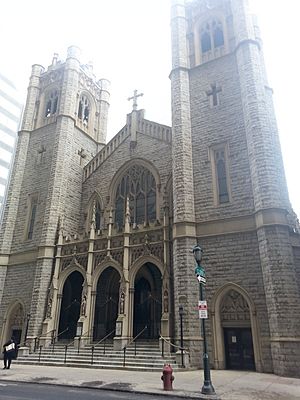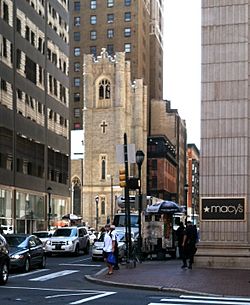St. John the Evangelist Catholic Church (Philadelphia, Pennsylvania) facts for kids
St. John the Evangelist Church is a special church community in Center City, Philadelphia. It belongs to the Roman Catholic Church and has a long history. From 1838 to 1864, it was even the main church, or "cathedral," for the area. The church building itself is very old, finished in 1832, and has a beautiful Gothic Revival style. You can find it on 13th Street, close to Market Street and Philadelphia City Hall.
Since 1991, a group of Franciscan priests called the Capuchins have been in charge of the church. Before that, regular priests from the diocese served the community.
Contents
What Happens at St. John's?
St. John's is a very busy church in Philadelphia. Many people come here for services. On Sundays, there are several Masses, which are special church services, held in the main part of the church. These happen at 8:30 a.m., 10:30 a.m., 12:30 p.m., and 6:00 p.m. There's also a Mass on Saturday evening at 5:15 p.m.
During the week, the church offers three Masses each day in a smaller area called the lower church. These are at 7:45 a.m., 12:05 p.m., and 5:15 p.m. These times are helpful for the many shoppers and workers in the busy Center City area. Long ago, there was even a special "Printers' Mass" at 2:45 a.m. on Sundays for people who worked late at night.
The church also offers confession, a chance to talk to a priest, on many days during the week. This is usually from 3:30 p.m. to 4:45 p.m. from Wednesdays through Saturdays. Even though not many families live right next to the church (only 821 homes are registered), it serves a huge number of people who work or visit the city center. You can find the weekly church bulletin online to see all the events and schedules.
A Look at St. John's History
How the Church Started
The idea for St. John's Church began on December 27, 1830. This was the feast day of St. John the Evangelist, and the Bishop, Francis P. Kenrick, gave permission for the church to be built. The church building was officially opened on April 8, 1832.
Inside, the church had beautiful art, including a painting by Nicholas Monachesi. In 1834, a famous piece of music, Mozart's Requiem Mass, was performed in the United States for the very first time at St. John's. Later that year, on August 1, a fire happened nearby, causing some damage.
When St. John's Was a Cathedral
In 1838, St. John's Church became the main church, or "Proto-Cathedral," for Philadelphia. The bishop even lived in the house next to the church. Before this, the main church was Old St. Mary's Church.
In 1844, there were serious events called the Nativist Riots. During these riots, some other Catholic churches were destroyed. To protect St. John's, soldiers placed cannons near the church. Because of this, St. John's was kept safe from the disturbances.
In the 1850s, two people who later became saints were connected to the church. Katherine Drexel received her first communion and confirmation there. Also, John Neumann, who became the new bishop in 1852, lived in the church's rectory.
From 1855 to 1860, a different group of priests, the Jesuits, managed the church. In 1864, a new, larger church, the Basilica of Saints Peter and Paul, became the main cathedral. St. John's then went back to being a regular parish church. At the time St. John's was the cathedral, there were about 170,000 Catholics in Philadelphia.
The Fire of 1899
In February 1899, a big fire badly damaged St. John's Church. The fire also affected many other buildings on the same block. Sadly, three firefighters died when part of the church collapsed, and another died later from getting sick while fighting the fire in the cold weather. A special Mass is held each year to remember them.
After the fire, the church school, which was in the basement, moved out. The basement area was then fixed up to become the "lower church." This allowed services to continue there while the main (upper) church was being repaired.
Connections Around the World
St. John's Church has some interesting connections to other countries. The first pastor, Father Hughes, became good friends with someone who had lived in Mexico. This led to strong ties with Mexico for many years. Mexican merchants in Philadelphia even helped the church financially.
When the exiled Mexican Emperor Augustín de Iturbide was executed in 1824, his family moved to Philadelphia. His wife, ex-Empress Ana Maria Huarte de Iturbide, is buried in St. John's Churchyard Cemetery, along with other family members. Later, in the 1920s, a group of nuns called the Sisters of the Visitation had to leave Mexico because of problems there. They lived at St. John's for several years before moving to their current home.
In 1939, a bishop named Yu Pin encouraged the Chinese community to connect with St. John's. Many Chinese people joined the parish. Eventually, a new chapel was opened about six blocks away in the heart of Chinatown. This chapel, now called Holy Redeemer Church, is still active today.
See also
 In Spanish: Iglesia de San Juan Evangelista (Filadelfia) para niños
In Spanish: Iglesia de San Juan Evangelista (Filadelfia) para niños




